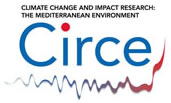2. Vulnerability indicators
Biogeophysical and social indicators are identified for which it is (or should be) possible to provide quantitative projections either through process-based or statistical modelling. These include peri-urban forest fires, ozone exceedance or anomalies; all-cause mortality; energy demand; marine characteristics; tourism, and wheat yields (all the rural case studies). It is also possible to provide quantitative estimates of some vulnerability indicators that are based on climate variables, such as a temperature-defined tourist season, or a rainfall and temperature-defined drought indicator. For other indicators, there is a lack of appropriate data / models to allow quantitative impact assessments, e.g., marine water quality in the Gulf of Valencia, shoreline changes in the Gulf of Gabès, and waterborne disease in Beirut. For these indicators, there is nonetheless, sufficient local evidence and knowledge of current trends and response to climate and non-climate drivers to allow more qualitative climate change impactsassessments.
Case study |
Quantitative |
Qualitative |
Athens: |
Peri-urban forest fires (I&V) |
|
Beirut: |
Heat-related mortality (I) |
Saline intrusion (V) |
Alexandria - |
Total Ozone column anomaly (V&I) |
Fire pixel count (V&I) |
Tuscany: |
Wheat yields (I) |
Land use (V) |
Puglia: |
Wine, wheat, oil production (I) |
Total value index for wine, wheat oil (I) |
Tel Hadya: |
Wheat yield (I) |
Water availability (V) |
Judean Foothills: |
Grain yield in rain-fed wheat (I) |
Land use (V) |
Gulf of Valencia: |
Salt-water intrusion (I&V) |
Coastal erosion (I&V) |
Gulf of Oran: |
Marine pollution discharges (I&V) |
Invasive marine species (jellyfish, green algae) (I) |
Gulf of Gabès: |
Alien marine species (I&V) |
Shoreline modification (I) |
 Integrating Case Studies
Integrating Case Studies